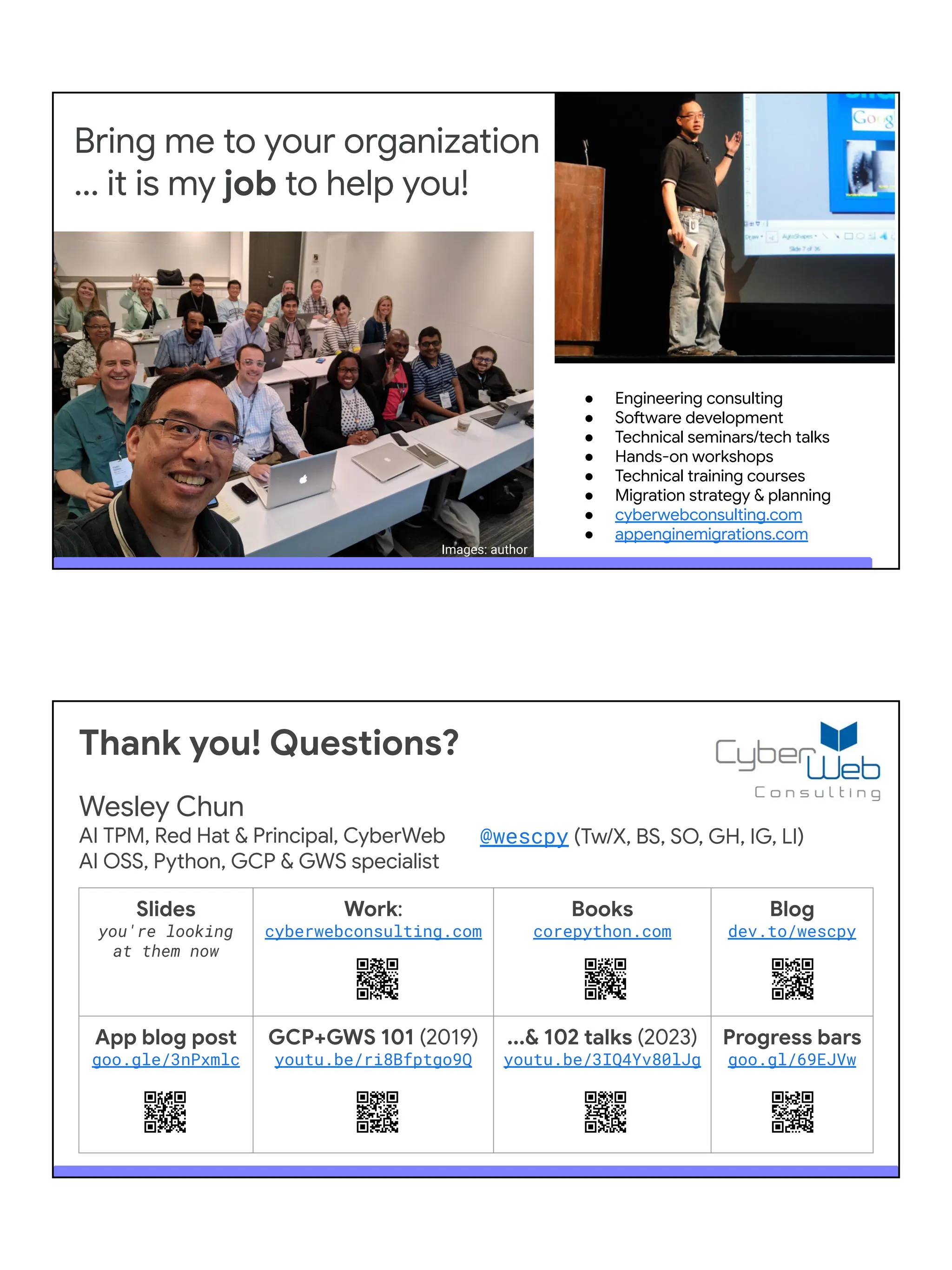Google provides a diverse array of services to realize the ambition of solving real business problems, like constrained resources. An image archive & analysis plus report generation use-case can be realized with just a variety of Google APIs, notably from the GWS (Google Workspace) & GCP (Google Cloud) product families. The app can be further enhanced with the GenAI API for the Gemini LLM as well as Google Maps. The principle of mixing-and-matching Google technologies is applicable to many other challenges faced by you, your organization, or your customers. These slides are from the 30-45-min presentation about this case study.



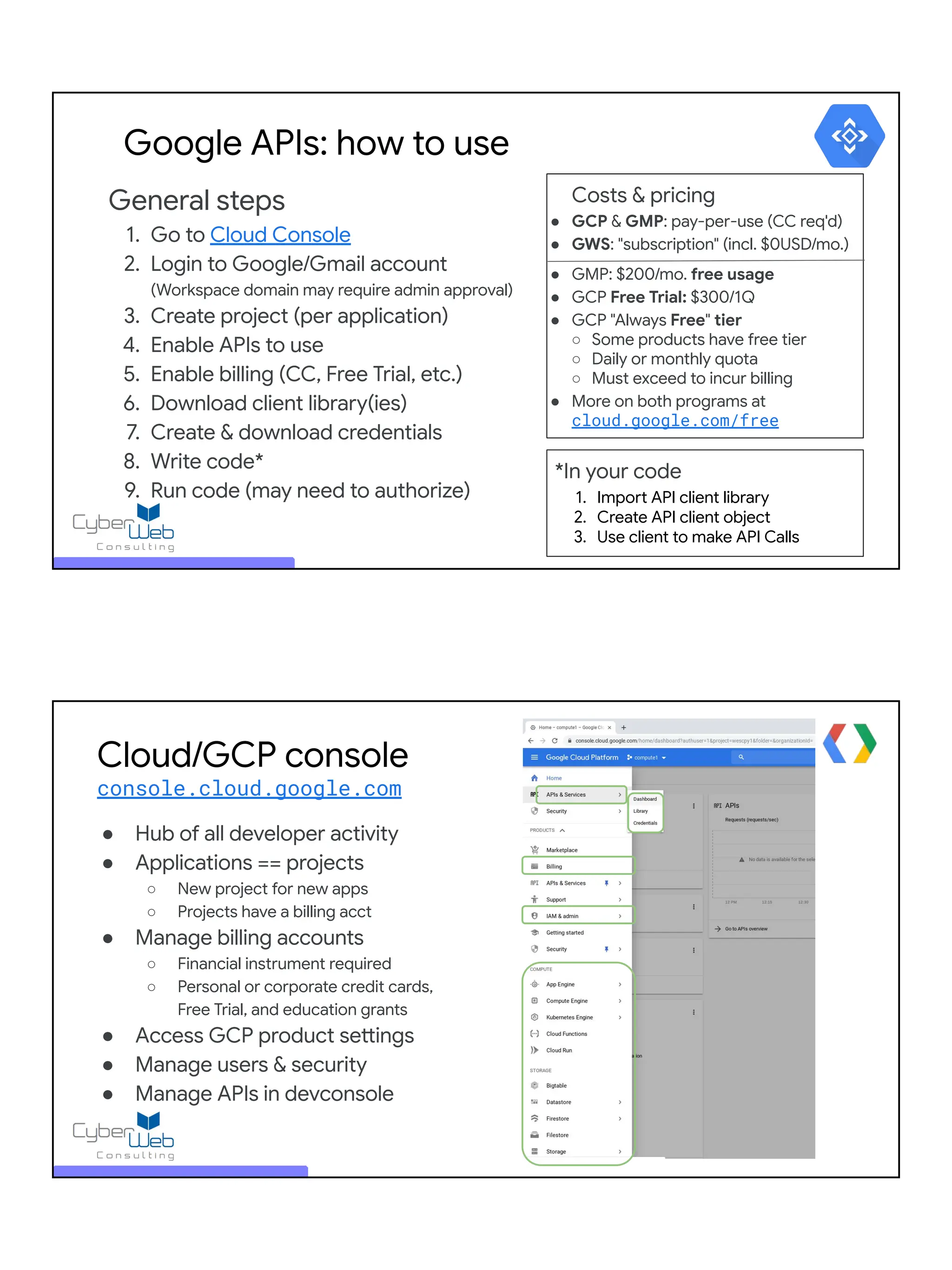
![● View application statistics ● En-/disable Google APIs ● Obtain application credentials Using Google APIs goo.gl/RbyTFD API manager aka Developers Console (devconsole) console.developers.google.com Three different credentials types ● Simple: API keys (to access public data) ○ Simplest form of authorization: an API key; tied to a project ○ Allows access to public data ○ Do not put in code, lose, or upload to GitHub! (can be restricted however) ○ Supported by: Google Maps, (some) YouTube, (some) GCP, etc. ● Authorized: OAuth client IDs (to access data owned by [human] user) ○ Provides additional layer of security via OAuth2 (RFC 6749) ○ Owner must grant permission for your app to access their data ○ Access granularity determined by requested permissions (user scopes) ○ Supported by: Google Workspace, (some) YouTube, (some) GCP, etc. ● Authorized: service accounts (to access data owned by an app/robot user) ○ Provides additional layer of security via OAuth2 or JWT (RFC 7519) ○ Project owning data grants permission implicitly; requires public-private key-pair ○ Access granularity determined by Cloud IAM permissions granted to service account key-pair ○ Supported by: GCP, (some) Google Workspace, etc. Blog series: dev.to/wescpy](https://image.slidesharecdn.com/chun-imgproc-2-50-251118082343-a0260e83/75/Build-an-AI-ML-driven-image-archive-processing-workflow-Image-archive-analysis-report-generation-5-2048.jpg)


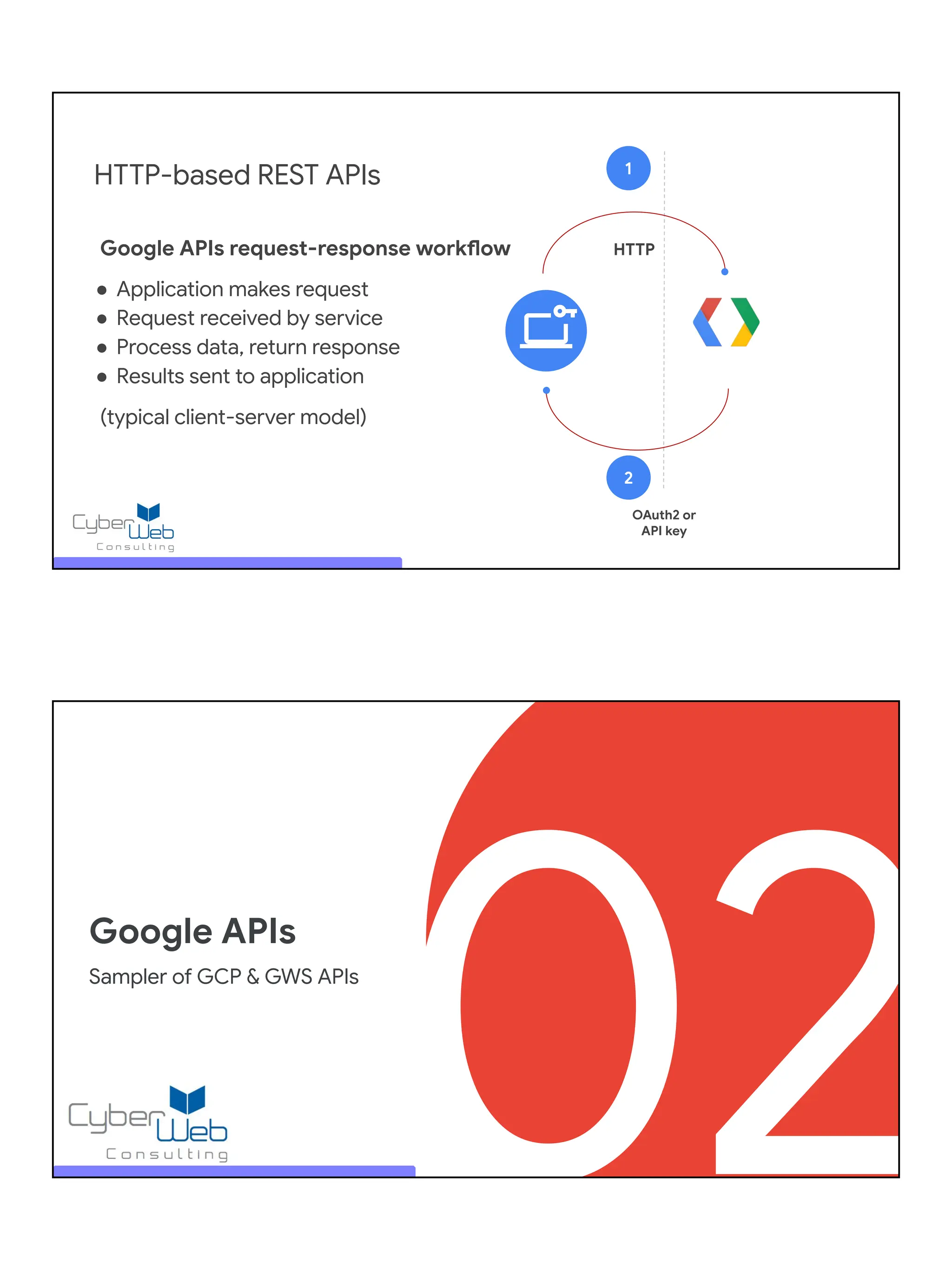
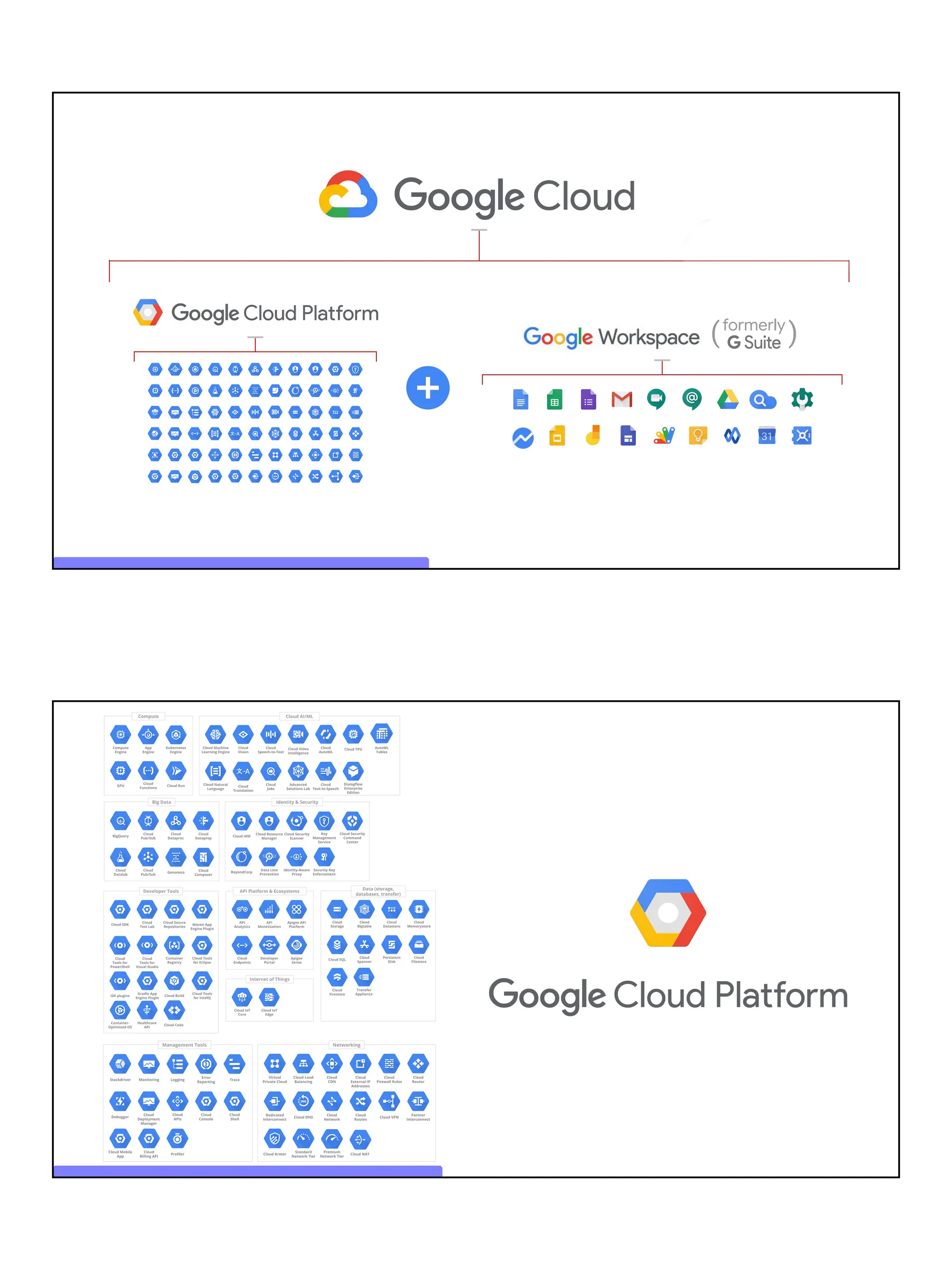
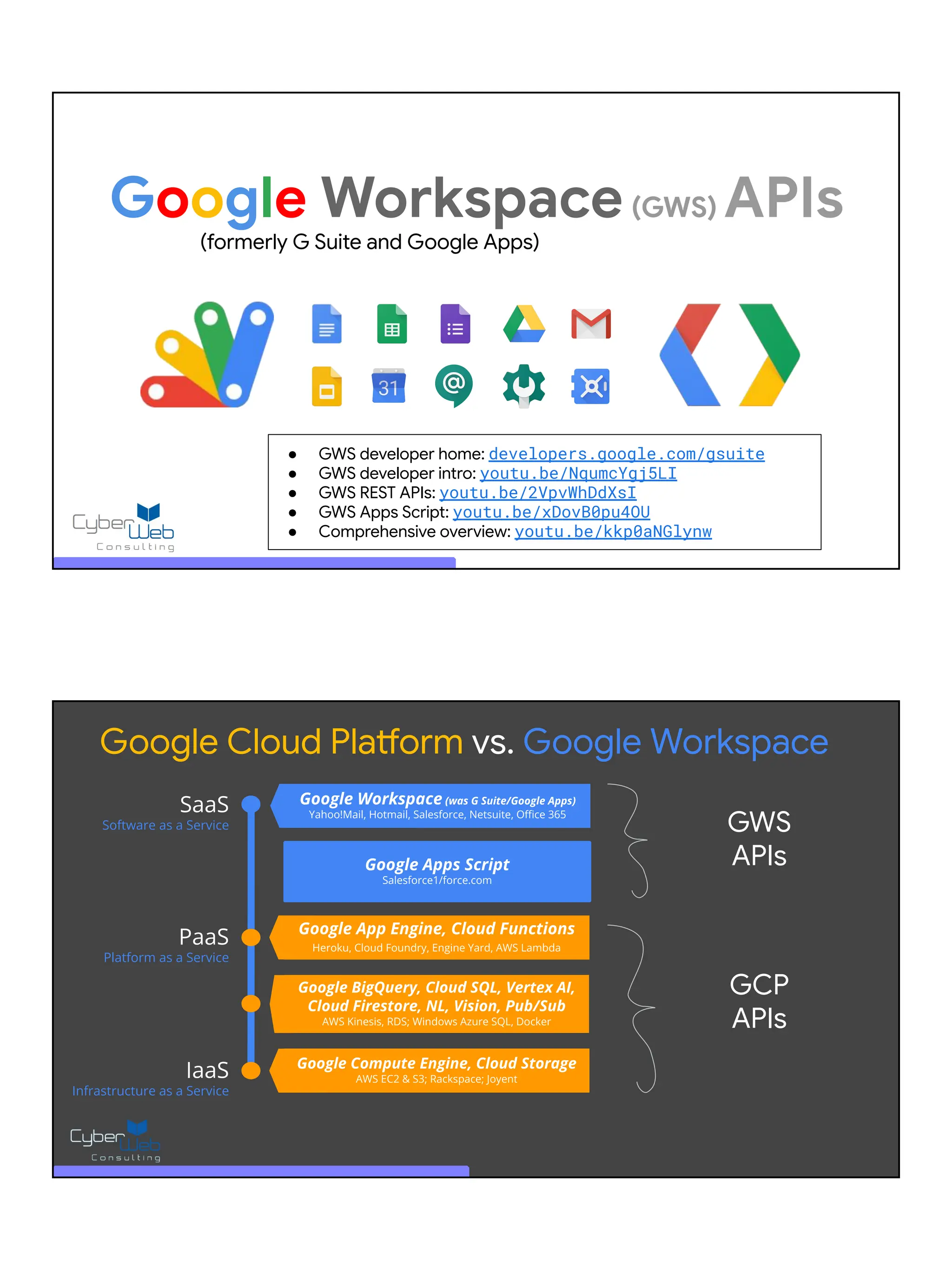
![List (first 100) files/folders in Drive (older, OAuth2) from __future__ import print_function from googleapiclient import discovery from httplib2 import Http from oauth2client import file, client, tools SCOPES = 'https://www.googleapis.com/auth/drive.metadata.readonly' store = file.Storage('storage.json') creds = store.get() if not creds or creds.invalid: flow = client.flow_from_clientsecrets('client_secret.json', SCOPES) creds = tools.run_flow(flow, store) DRIVE = discovery.build('drive', 'v3', http=creds.authorize(Http())) files = DRIVE.files().list().execute().get('files', []) for f in files: print(f['name'], f['mimeType']) Listing your files goo.gl/ZIgf8k github.com/wescpy/gsuite-apis-intro Migrate SQL data to a Sheet # read SQL data then create new spreadsheet & add rows into it FIELDS = ('ID', 'Customer Name', 'Product Code', 'Units Ordered', 'Unit Price', 'Status') cxn = sqlite3.connect('db.sqlite') cur = cxn.cursor() rows = cur.execute('SELECT * FROM orders').fetchall() cxn.close() rows.insert(0, FIELDS) DATA = {'properties': {'title': 'Customer orders'}} SHEET_ID = SHEETS.spreadsheets().create(body=DATA, fields='spreadsheetId').execute().get('spreadsheetId') SHEETS.spreadsheets().values().update(spreadsheetId=SHEET_ID, range='A1', body={'values': rows}, valueInputOption='RAW').execute() Migrate SQL data to Sheets goo.gl/N1RPwC](https://image.slidesharecdn.com/chun-imgproc-2-50-251118082343-a0260e83/75/Build-an-AI-ML-driven-image-archive-processing-workflow-Image-archive-analysis-report-generation-11-2048.jpg)
![Storage: listing buckets from __future__ import print_function from googleapiclient import discovery GCS = discovery.build('storage', 'v1') BUCKET = YOUR_BUCKET # send bucket name & return fields to API, display results print('n** Objects in bucket %r...' % BUCKET) FIELDS = 'items(name,size)' files = GCS.objects().list(bucket=BUCKET, fields=FIELDS ).execute().get('items') or [{'name': '(none)', 'size': 'NaN'}] for f in files: print(' %s (%s)' % (f['name'], f['size'])) IMG = 'gs://cloud-samples-data/vision/using_curl/shanghai.jpeg' body = {'requests': [{ 'image': {'source': {'imageUri': IMG}}, 'features': [{'type': 'LABEL_DETECTION'}], }]} VISION = discovery.build('vision', 'v1', developerKey=API_KEY) labeling = VISION.images().annotate(body=body).execute().get('responses') for labels in labeling: if 'labelAnnotations' in labels: print('** Labels detected (and confidence score):') for label in labels['labelAnnotations']: print(label['description'], '(%.2f%%)' % (label['score']*100.)) Vision: label annotation/object detection](https://image.slidesharecdn.com/chun-imgproc-2-50-251118082343-a0260e83/75/Build-an-AI-ML-driven-image-archive-processing-workflow-Image-archive-analysis-report-generation-12-2048.jpg)
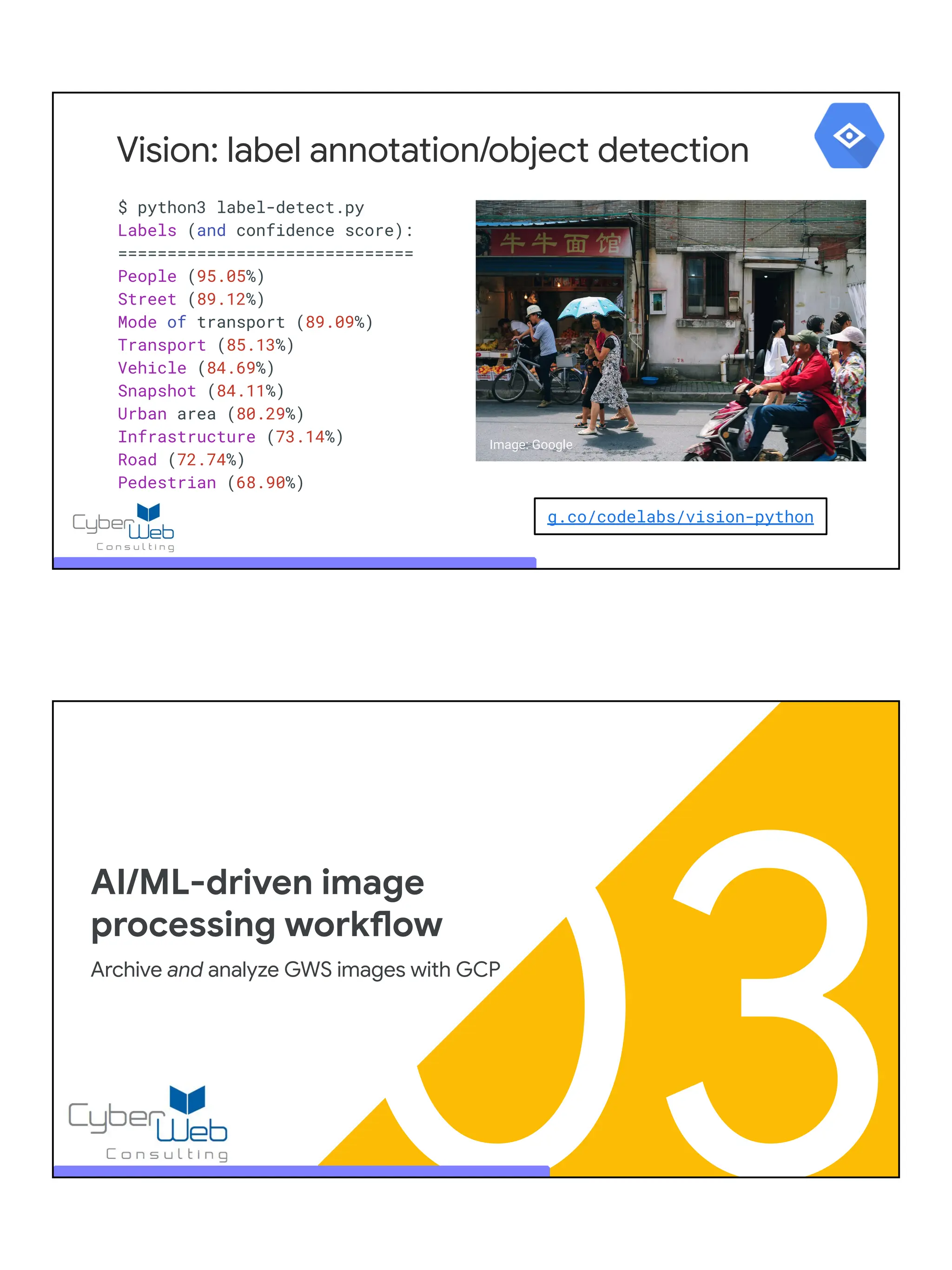
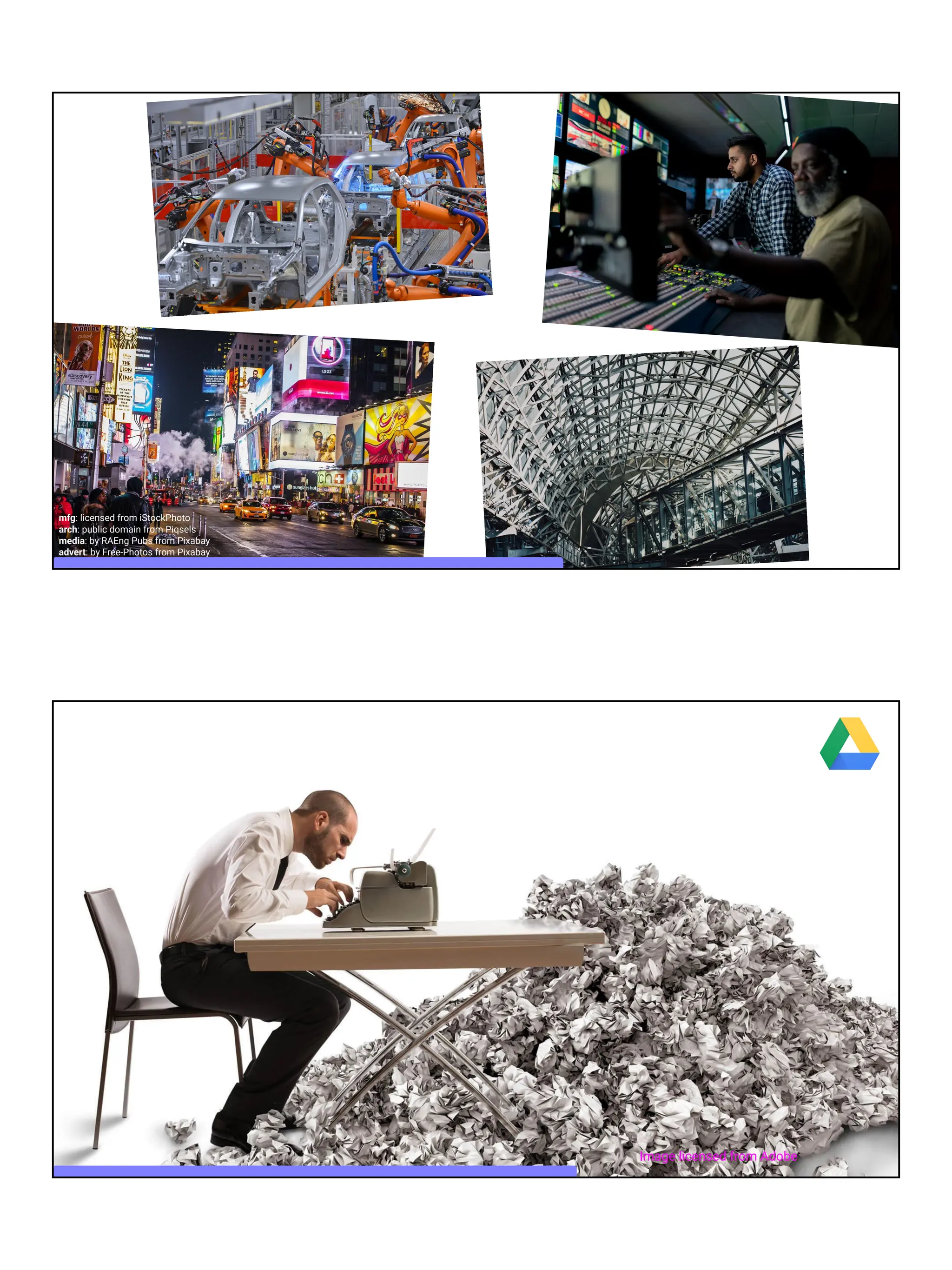


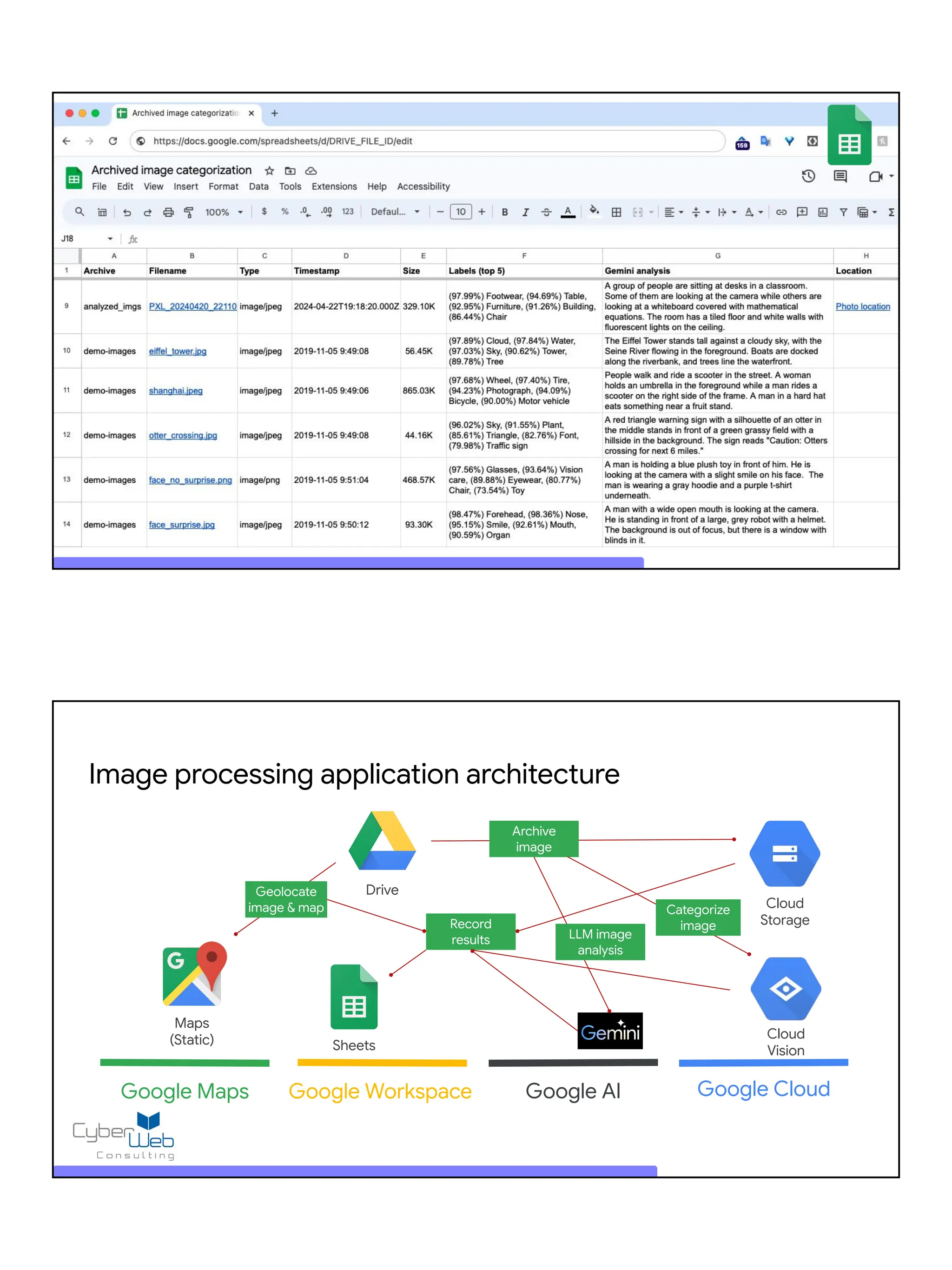
![Application initialization and API setup from __future__ import print_function import argparse, base64, io, os, sys, time, webbrowser from googleapiclient import discovery, http from httplib2 import Http from oauth2client import file, client, tools from PIL import Image from google import genai from settings import API_KEY k_ize = lambda b: '%6.2fK' % (b/1000.) # bytes to kBs FILE = 'YOUR_IMG_ON_DRIVE' BUCKET = 'YOUR_BUCKET_NAME' SHEET = 'YOUR_SHEET_ID' TOP = 5 # get top Vision API labels DEBUG = False # create Gemini API client object plus constants PROMPT = 'Describe this image in 2-3 sentences' MODEL = 'gemini-2.5-flash' GENAI = genai.Client(api_key=API_KEY) # process credentials for OAuth2 tokens SCOPES = ( 'https://www.googleapis.com/auth/drive.readonly', 'https://www.googleapis.com/auth/devstorage', 'https://www.googleapis.com/auth/cloud-vision', 'https://www.googleapis.com/auth/spreadsheets', ) store = file.Storage('storage.json') creds = store.get() if not creds or creds.invalid: flow = client.flow_from_clientsecrets( 'client_secret.json', SCOPES) creds = tools.run_flow(flow, store) # create Google API client objects HTTP = creds.authorize(Http()) DRIVE = discovery.build('drive', 'v3', http=HTTP) GCS = discovery.build('storage', 'v1', http=HTTP) VISION = discovery.build('vision', 'v1', http=HTTP) SHEETS = discovery.build('sheets', 'v4', http=HTTP) def drive_get_file(fname): rsp = DRIVE.files().list(q="name='%s'" % fname).execute().get['files'][0] fileId, fname, mtype = rsp['id'], rsp['name'], rsp['mimeType'] blob = DRIVE.files().get_media(fileId).execute() return fname, mtype, rsp['modifiedTime'], blob, drive_geoloc_maps(fileId) Individual API components def drive_geoloc_maps(file_id): imd = DRIVE.files().get(fileId=file_id).execute().get('imageMediaMetadata') return 'https://maps.googleapis.com/maps/api/staticmap?size=480x480&markers=%s,%s&key=%s' % ( imd['location']['latitude'], imd['location']['longitude'], API_KEY) def genai_analyze_img(media): image = Image.open(io.BytesIO(media)) return GENAI.models.generate_content( model=MODEL, contents=(PROMPT, image)).text.strip() def sheet_append_row(sheet, row): rsp = SHEETS.spreadsheets().values().append( spreadsheetId=sheet, range='Sheet1', body={'values': rows}).execute() return rsp.get('updates').get('updatedCells') def vision_label_img(img, top): body = {'requests': [{'image': {'content': img}, 'features': [{'type': 'LABEL_DETECTION', 'maxResults': top}]}]} rsp = VISION.images().annotate( body=body).execute().get('responses', [{}])[0] return ', '.join('%s (%.2f%%)' % (label['description'], label['score']*100.) for label in rsp['labelAnnotations']) def gcs_blob_upload(fname, bucket, blob, mimetype): body = {'name': fname, 'uploadType': 'multipart', 'contentType': mimetype} return GCS.objects().insert(bucket, body, blob).execute()](https://image.slidesharecdn.com/chun-imgproc-2-50-251118082343-a0260e83/75/Build-an-AI-ML-driven-image-archive-processing-workflow-Image-archive-analysis-report-generation-18-2048.jpg)
![Acquire file info from Drive; Maps geolocation def drive_get_file(fname): rsp = DRIVE.files().list( q="name='%s'" % fname).execute().get['files'][0] fileId, fname, mtype = rsp['id'], rsp['name'], rsp['mimeType'] blob = DRIVE.files().get_media(fileId).execute() return mtype, rsp['modifiedTime'], blob, drive_geoloc_maps(fileId) Upload file media/binary/blob to Google Cloud Storage def gcs_blob_upload(fname, bucket, blob, mimetype): body = { 'name': fname, 'uploadType': 'multipart', 'contentType': mimetype } return GCS.objects().insert( bucket, body, blob).execute()](https://image.slidesharecdn.com/chun-imgproc-2-50-251118082343-a0260e83/75/Build-an-AI-ML-driven-image-archive-processing-workflow-Image-archive-analysis-report-generation-19-2048.jpg)
![Cloud Vision label annotation (image contents) def vision_label_img(img, top): body = [{'image': {'content': img}, 'features': [{ 'type': 'LABEL_DETECTION', 'maxResults': top, }] }] rsp = VISION.images().annotate( body={'requests': body}).execute()['responses'][0] return ', '.join('%s (%.2f%%)' % ( label['description'], label['score']*100.) for label in rsp['labelAnnotations']) Analyze & describe image contents with LLM from PIL import Image from google import genai from settings import API_KEY # gen AI setup PROMPT = 'Describe this image in 2-3 sentences' MODEL = 'gemini-2.5-flash' GENAI = genai.Client(api_key=API_KEY) def genai_analyze_img(media): 'analyze image with genAI LLM and return analysis' image = Image.open(io.BytesIO(media)) return GENAI.models.generate_content( model=MODEL, contents=(PROMPT, image)).text.strip()](https://image.slidesharecdn.com/chun-imgproc-2-50-251118082343-a0260e83/75/Build-an-AI-ML-driven-image-archive-processing-workflow-Image-archive-analysis-report-generation-20-2048.jpg)
![Create Google Maps map if image geolocated MAPS_URL = 'https://maps.googleapis.com/maps/api/staticmap?size=480x480&markers=' def drive_geoloc_maps(file_id): imd = DRIVE.files().get(fileId=file_id, fields='imageMediaMetadata').execute().get('imageMediaMetadata') if not imd or 'location' not in imd: return '' return '%s%s,%s&key=%s' % (MAPS_URL, imd['location']['latitude'], imd['location']['longitude'], API_KEY) Store all results in one row to Google Sheets def sheet_append_row(sheet, row): rsp = SHEETS.spreadsheets().values().append( spreadsheetId=sheet, range='Sheet1', body={'values': row}).execute() return rsp.get('updates').get('updatedCells')](https://image.slidesharecdn.com/chun-imgproc-2-50-251118082343-a0260e83/75/Build-an-AI-ML-driven-image-archive-processing-workflow-Image-archive-analysis-report-generation-21-2048.jpg)
![Complete image processing workflow def main(fname, bucket, sheet_id, top): fname, mtype, ftime, data, maps = drive_get_img(fname) gcs_blob_upload(fname, bucket, data, mtype) viz = vision_label_img(data, top) gem = genai_analyze_img(data) sheet_append_row(sheet_id, [fname, mtype, ftime, len(data), viz, gem, maps]) ● Project goal: Imagining an actual enterprise use case and solve it! ● Specific goals: free-up highly-utilized resource, archive data to colder/cheaper storage, analyze images, generate report for mgmt ● Download image binary from Google Drive ● If image geolocated use Google Maps to create static map ● Upload object to Cloud Storage bucket ● Process image label/object detection by Cloud Vision ● GenAI request for Gemini to summarize image contents ● Write back-up location & analysis results into Google Sheets ● Blog post: goo.gle/3nPxmlc (original post); Cloud X-post ● Codelab: free, online, self-paced, hands-on tutorial ● g.co/codelabs/drive-gcs-vision-sheets ● Application source code (Gemini & Maps version in /alt) ● github.com/wescpy/analyze_gsimg App summary](https://image.slidesharecdn.com/chun-imgproc-2-50-251118082343-a0260e83/75/Build-an-AI-ML-driven-image-archive-processing-workflow-Image-archive-analysis-report-generation-22-2048.jpg)
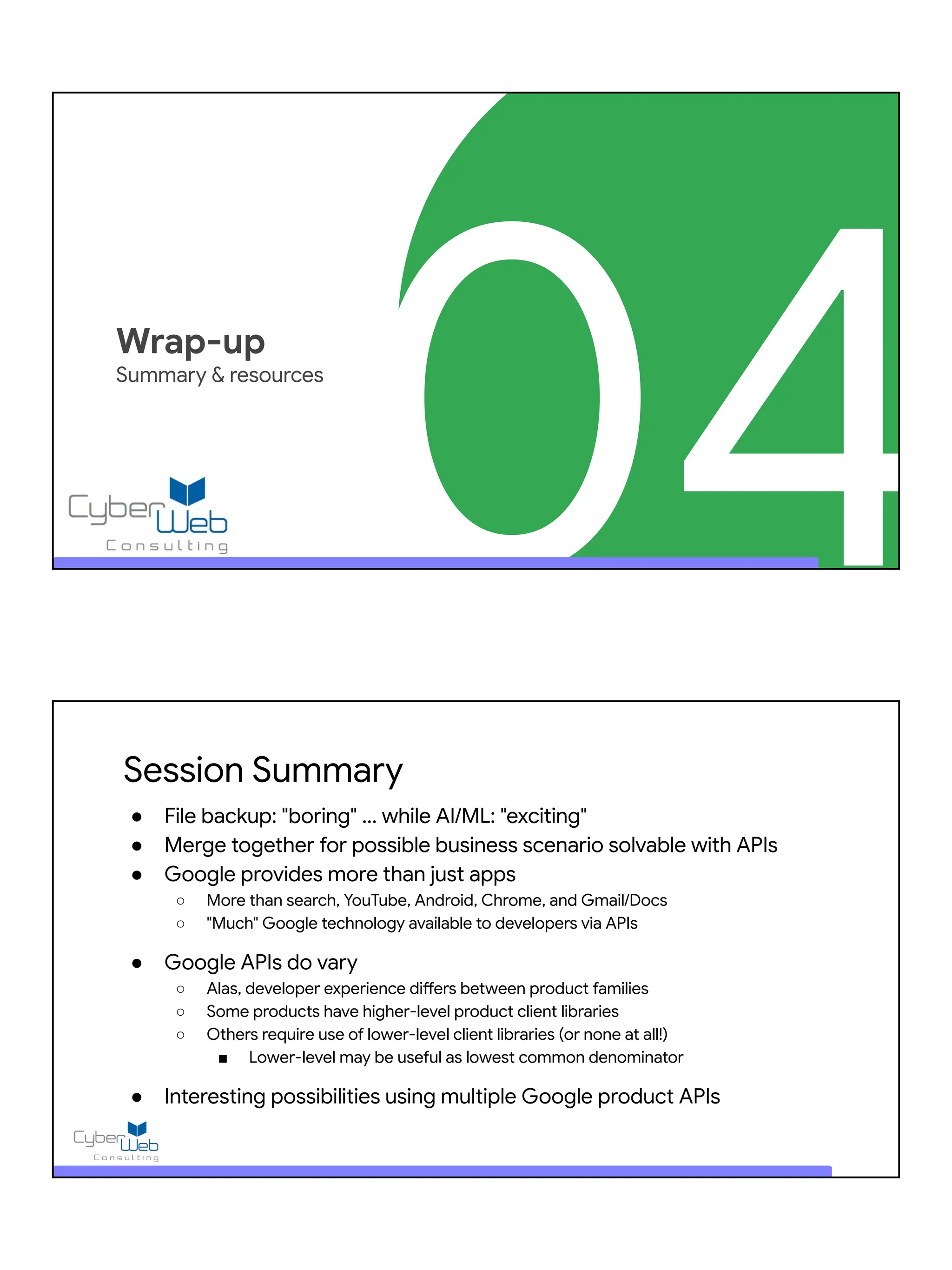
![Other Google APIs & platforms ● Firebase (mobile development platform + RT DB; ML Kit) ○ firebase.google.com & firebase.google.com/docs/ml-kit ● Google Looker/Data Studio (data visualization, dashboards, etc.) ○ datastudio.google.com/overview ○ goo.gle/datastudio-course ● Actions on Google/Assistant/DialogFlow (voice apps) ○ developers.google.com/actions ● YouTube (Data, Analytics, and Livestreaming APIs) ○ developers.google.com/youtube ● Google Maps (Maps, Routes, and Places APIs) ○ developers.google.com/maps ● Flutter (native apps [Android, iOS, web] w/1 code base[!]) ○ flutter.dev ● Documentation ○ GCP: cloud.google.com/{docs,vision,automl,storage,language,speech,translate,firestore,sql, video-intelligence,bigquery,filestore,identity-platform,vertex-ai,kubernetes,compute,gpu,tpu} ○ GWS & other non-GCP: developers.google.com/{gsuite,gmail,drive,calendar,docs,sheets, slides,forms,classroom,chat,apps-script,maps,youtube,analytics,cast,actions,people,ar,books} ● Introductory "codelabs" ([free] self-paced, hands-on tutorials) ○ GWS APIs: g.co/codelabs/gsuite-apis-intro (featuring Drive API) ○ Cloud Vision API: g.co/codelabs/vision-python (or C#) ○ All other codelabs: g.co/codelabs (all Google APIs, all levels) ● Videos ○ GWS: goo.gl/JpBQ40, Drive: developers.google.com/drive/web/videos, Sheets: developers.google.com/sheets/api/videos, GCP: youtube.com/GoogleCloudPlatform ● Code: github.com/GoogleCloudPlatform & github.com/googleworkspace ● GCP Free Trial (new users) and Always Free tier: cloud.google.com/free ● Compare GCP to AWS and Azure: cloud.google.com/docs/compare/aws Online resources](https://image.slidesharecdn.com/chun-imgproc-2-50-251118082343-a0260e83/75/Build-an-AI-ML-driven-image-archive-processing-workflow-Image-archive-analysis-report-generation-24-2048.jpg)
